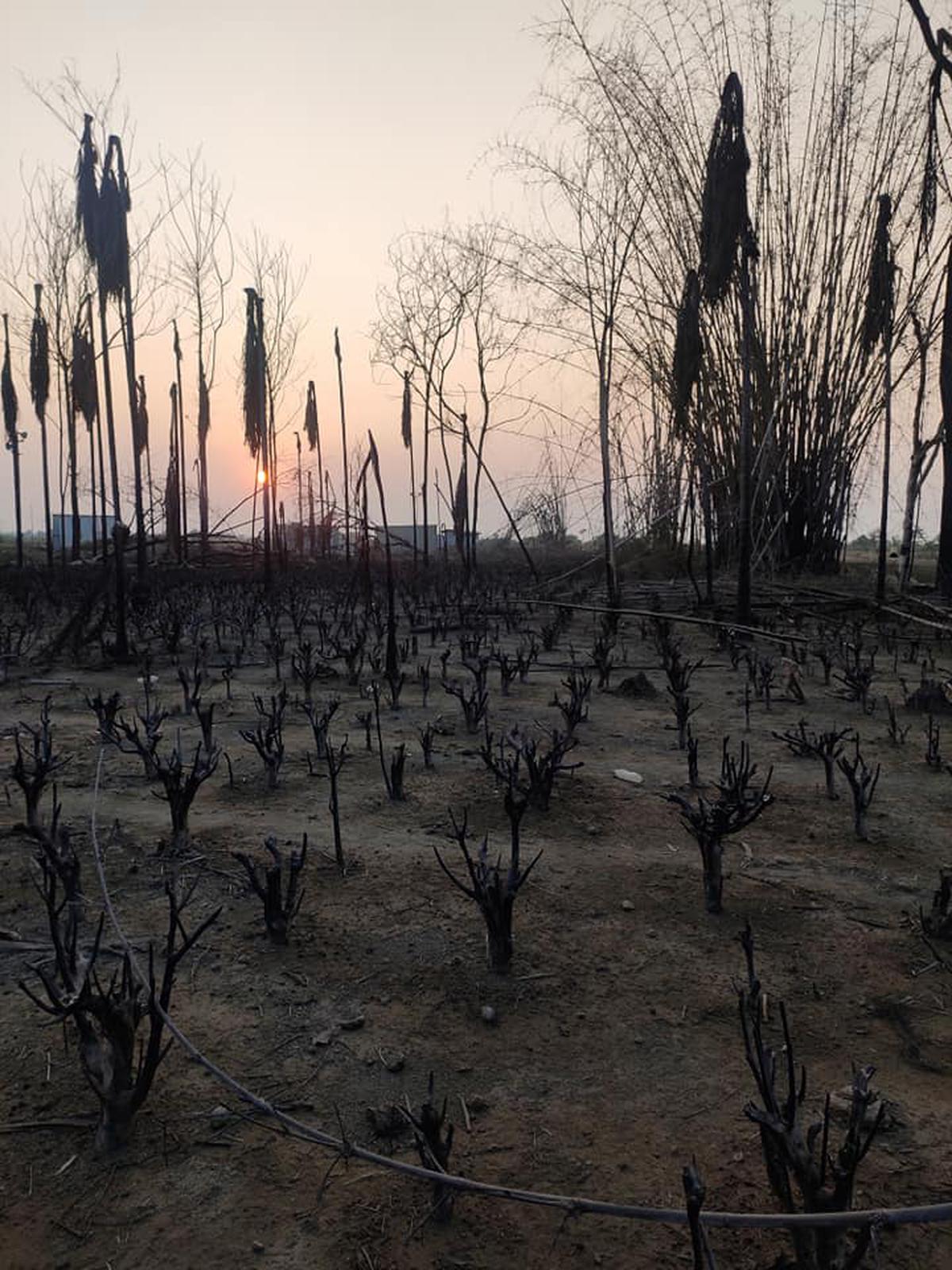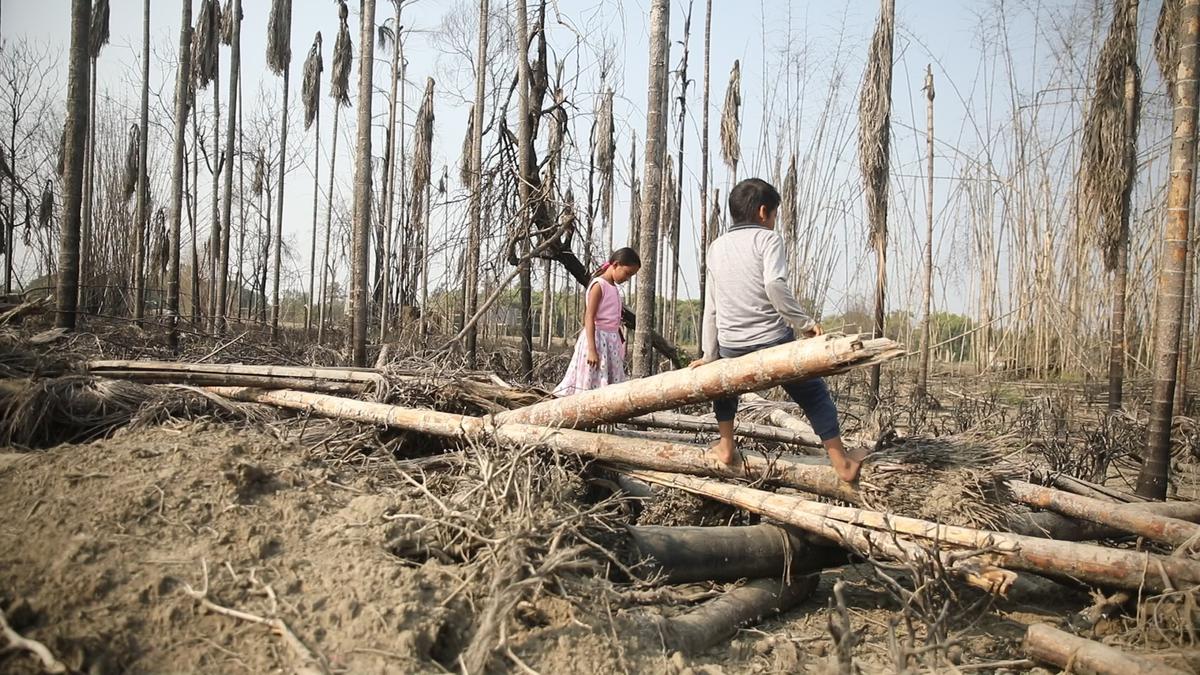Baghjan Reels poignant account
A documentary depicts the Moran community’s struggle to rebuild lives from the ashes of the longest oil field fire in Assam’s Baghjan village, which occurred two years ago
A documentary depicts the Moran community’s struggle to rebuild lives from the ashes of the longest oil field fire in Assam’s Baghjan village, which occurred two years ago
Tahin Ojah Sharma, a 42-year-old FTII-trained filmmaker living in Mumbai for two decades, became curious when news about India’s longest oil well fire in her home State, Assam, started fading away from mainstream media even before it caught the country’s attention.
A gas leak in Baghjan oil field in Tinsukia district in upper Assam first made headlines on May 27, 2020. Within a fortnight, fire broke out following an explosion in one of the oil wells on June 9. It took more than five months to kill the blowout and extinguish the fire on November 15. All along, Tahin kept herself abreast with every news report and google update and was surprised to see how videos of the Vishakhapatnam gas leak that happened 20 days earlier went viral, but Baghjan failed to create a stir.
The incident happened when everyone was reeling under the fear of COVID uncertainties ahead, says Tahin. As a result of the second COVID wave, she could not visit the site till about a few months ago. “I was getting restless about lack of inputs on the environmental degradation following the fire and how it had impacted the local population, flora and fauna,” she says.
Hailing from the region, it was not difficult for Tahin to visualise the circumstances of the affected Moran community — the early inhabitants of Baghjan — and how the fire consumed their homes, livestock and livelihoods.

A shot from the documentary Baghjan Reels by Tahin Ojah Sharma
| Photo Credit: Special Arrangement
True to her fears, when she drove into Baghjan village last winter for the first time after the fire, she was numbed by the large-scale destruction. “The once green and fertile land of betel and tea plantations, banana orchards and bamboo groves was now a deserted wasteland. It was a haunting visual with ash-laden burnt trees and brick houses all around; dead fish and carcass of domestic animals and pets floating on smelly oil-coated water,” she recalls.
Farming, animal rearing and fishing were the primary occupation of the people here, and Tahin set out in search of them. “Everybody had fled. I found only 15 members from three families, who had returned to their burnt homes and started living in temporary shelters made of tin,” she says and adds that it is their voices she wants the people to hear. That is how the documentary took birth.
The serious health risk from lingering toxic fumes, oil spill and all-pervasive contaminants are issues ignored by the authorities as the residents who have returned have no choice but to cope with the aftermath. Tahin’s 34-minute documentary is soul-stirring as you hear helpless locals narrate their trauma.

A shot from the documentary Baghjan Reels by Tahin Ojah Sharma
| Photo Credit: Special Arrangement
Having witnessed an inferno, they continue to suffer from anxiety besides a host of physical health issues such as damage to their ears and respiratory tracts. The fight for compensation and justice is another struggle for the 1,500 families that got displaced.
“It was difficult to convince the villagers to speak to me, as they feared exploitation. One of them questioned me, asking why I was trying to make money out of their tragedy,” says Tahin.
Oil drilling without any respect for the environment and the eco-sensitive zones, according to Tahin, has also altered the landscapes of the Maguri-Motapung wetland and Dibru-Saikhowa National Park on the banks of the Dibru river. For long, these spaces have sustained local communities besides 500 species of birds, 106 species of fish, 105 butterfly species, 680 types of plants and 40 mammals.
“The trail of destruction is beyond lost crops and damaged homes. Suffering is not just about data, it is about health and lives,” says Tahin, who was shocked to see people consuming the water that is still smelly and tastes bad, and even fishing in the contaminated ponds for survival. “Nobody seems to care for this stretch of land anymore and there is no restorative process or rehabilitation plan for the people in sight,” she says.
Tahin spent five days at the site and recorded 200 hours of footage. Her documentary highlights stark images of a decimated village and the pain of those who lived there once. The film has been received well in the international film circuit.

Tahin Ojah Sharma, Director of documentary Baghjan Reels
| Photo Credit: Special Arrangement
Meet the filmmaker
Tahin Ojah Sharma has received recognition on multiple platforms
• Special Mention Award in the 5th National Rural development film festival, 2021
• Finalist at Boden International Film Festival (Sweden) June, 2021
Official selection for the LiftOff sessions July 2021
• Official selection for the 14th International Kuala Lumpur Eco Film Festival, 2021
For all the latest Entertainment News Click Here
For the latest news and updates, follow us on Google News.
